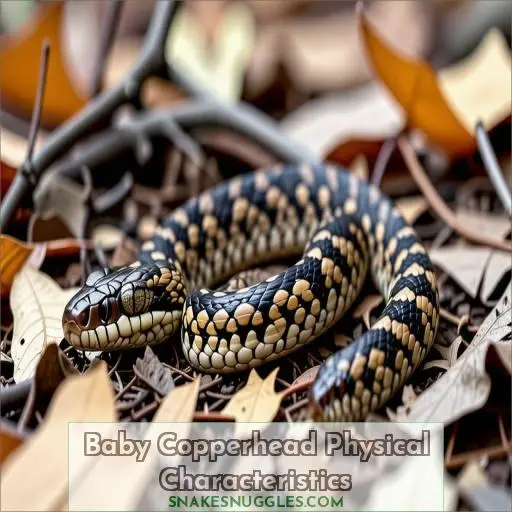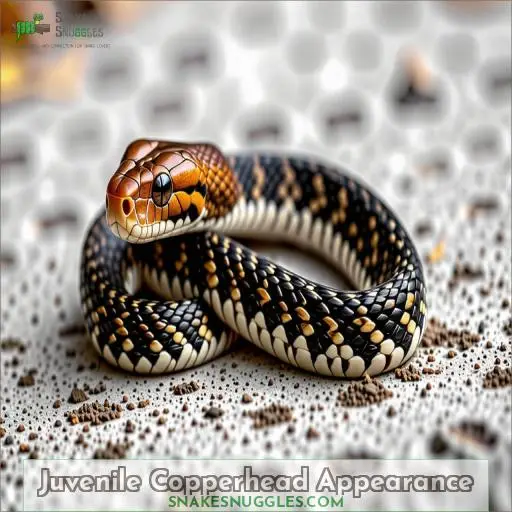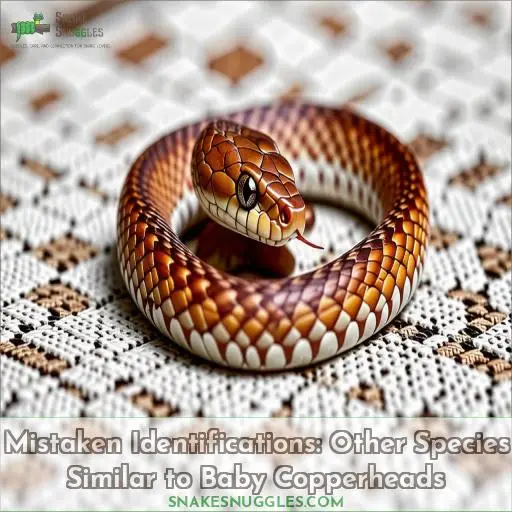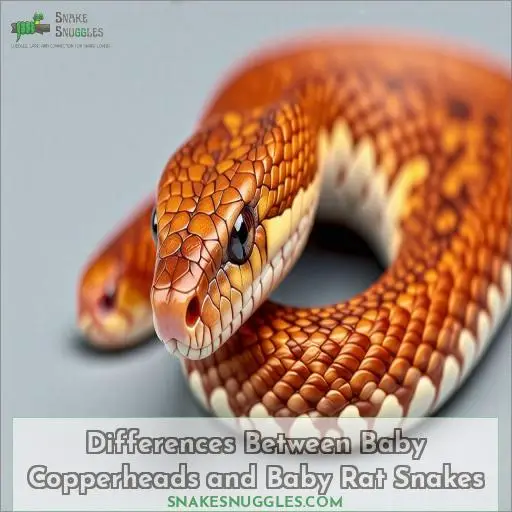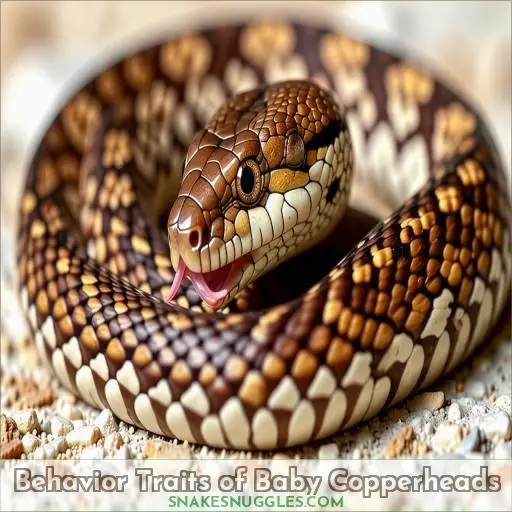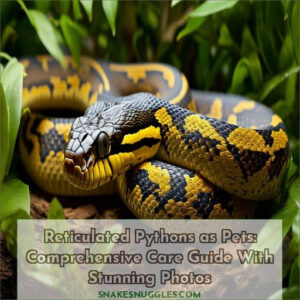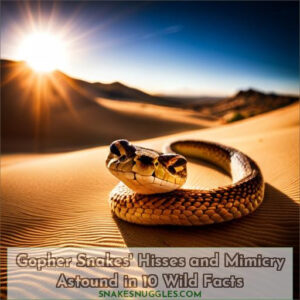This site is supported by our readers. We may earn a commission, at no cost to you, if you purchase through links.
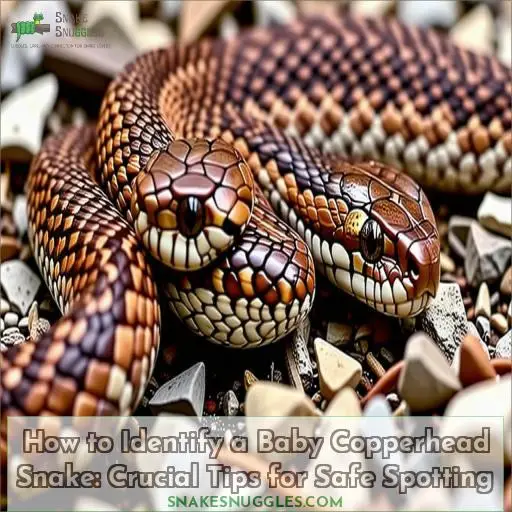 You’ll want to keep an eye out for a few key traits when identifying a baby copperhead snake:
You’ll want to keep an eye out for a few key traits when identifying a baby copperhead snake:
That distinctive vibrant yellow or green tail tip, diamond-shaped head, and hourglass-patterned bands along the body.
These little guys have keeled scales too, giving them a rough texture.
Stay alert though – some harmless lookalikes like the eastern ratsnake can easily be mistaken for a baby copperhead at first glance.
Scrutinize that head shape and tail color closely.
One wrong ID could spell trouble, so take your time to verify those telltale signs before getting too close.
There’s more to learn if you’re inclined.
Table Of Contents
- Key Takeaways
- How to Identify a Baby Copperhead Snake?
- Baby Copperhead Physical Characteristics
- Juvenile Copperhead Appearance
- Mistaken Identifications: Other Species Similar to Baby Copperheads
- Differences Between Baby Copperheads and Baby Rat Snakes
- Behavior Traits of Baby Copperheads
- Frequently Asked Questions (FAQs)
- How to identify a copperhead baby?
- What does a juvenile copperhead look like?
- What snake is mistaken for a copperhead?
- How do you tell the difference between a baby copperhead and a baby rat snake?
- Are baby copperhead bites more dangerous than adult bites?
- How can I safely remove a copperhead from my yard?
- What time of year are baby copperheads born?
- Do copperheads climb trees and bushes?
- How common are copperhead snake bites in humans?
- Conclusion
Key Takeaways
- Look for the distinctive vibrant yellow or green tail tip, diamond-shaped head, and hourglass-patterned bands along the body to identify a baby copperhead snake.
- Scrutinize the head shape and tail color closely, as some harmless lookalikes like the eastern ratsnake can easily be mistaken for a baby copperhead at first glance.
- Carefully observe the physical characteristics of baby copperheads, including their keeled scales, coloration, and size (typically 7-9 inches long).
- Understand the habitat preferences and behavior traits of baby copperheads, such as their preference for humid habitats, coiling up when threatened, and their diets primarily consisting of small rodents and lizards.
How to Identify a Baby Copperhead Snake?
To identify a baby copperhead snake, look for its distinctive hourglass-shaped bands that are reddish-brown in color and darker at the edges. Baby copperheads have a copper-colored head, vertical pupils, and a heat-sensing pit between their eyes and nostrils, which helps them locate warm-blooded prey.
Baby Copperhead Physical Characteristics
Concerning the identification of baby copperheads, their physical characteristics are a blatant giveaway.
These pint-sized pit vipers possess a vibrant yellow or green tail tip that fades as they mature.
Their diamond-shaped head and hourglass-shaped bands along their body are also telltale signs.
Baby copperheads are typically 7-9 inches long and have keeled scales that grant them a rough texture.
While their coloration ranges from light brown to reddish, some may appear dark gray.
These venomous snakes favor humid habitats such as swamps, rivers, and rocky, forested areas.
If threatened, baby copperheads will coil up, maintain their position, and even strike.
Their diet primarily consists of small rodents and lizards.
Juvenile Copperhead Appearance
As a baby copperhead emerges into the world, its most distinctive feature is the bright yellow or lime green tail tip (Source). This eye-catching appendage serves two key purposes – attracting prey and warning off potential predators . Newborn copperheads are only 7-9 inches long and highly vulnerable . Their small size makes them easy targets for larger animals.
Baby copperheads share the same physical traits as adults, including:
- Spear-shaped head
- Hourglass-shaped bands in shades of brown or reddish-brown
- Keeled scales
- Vertical, elliptical pupils
These tiny terrors prefer moist habitats like swamps, rivers, and rocky, forested areas . As the weather cools, they’ll seek shelter for hibernation, emerging in spring ready to hunt .
Mistaken Identifications: Other Species Similar to Baby Copperheads
Many harmless snake species can be mistaken for juvenile copperheads due to their similar banded patterns, such as the Eastern ratsnake, Northern black racer, Northern watersnake, Eastern milksnake, Eastern hog-nosed snake, red cornsnake, and Northern mole kingsnake. Careful observation of physical characteristics like head shape, pupil shape, heat-sensing pits, and keeled scales is essential for proper identification.
Eastern Ratsnake
The Eastern Ratsnake is often mistaken for a baby copperhead due to its grayish background and blotches on the sides that widen near the backbone, resembling the hourglass-shaped bands of the copperhead.
It’s found statewide and may seek winter refuge in human dwellings, posing potential confusion for snake spotters.
Understanding these distinguishing features will help guarantee a safe encounter with these snakes.
Northern Black Racer
The Northern Black Racer is another snake often mistaken for a baby copperhead. As juveniles, they’ve a blotched pattern that fades to solid black within two years. Unlike copperheads, racers are found statewide and are one of the first snakes active in spring. Avoid handling any snake, as even a baby copperhead bite requires immediate medical attention.
Northern Watersnake
The northern watersnake is another snake commonly mistaken for a baby copperhead.
While it shares some similarities like a brown or reddish-brown pattern, the northern watersnake has a narrower pattern on its sides and is usually found near water.
Its head isn’t as wide as a copperhead’s, and it lacks heat-sensing pits.
Appreciate these snakes from a safe distance and never handle them, as they can deliver a painful bite when threatened.
Eastern Milksnake
The Eastern Milksnake is a non-venomous snake often mistaken for the venomous Copperhead due to its similar color pattern. However, Milksnakes have smooth scales, a V or Y shaped blotch on the neck, and a black-and-white checkered belly. They prefer open habitats like fields and rocky areas, and are common throughout the Eastern United States(Source).
Eastern Hog-nosed Snake
The Eastern Hog-nosed Snake has a unique diamond-shaped head, hourglass-shaped bands, and keeled scales. Often mistaken for a baby copperhead, it differs in behavior, habitat, diet, and reproduction. Understanding these differences is essential for safe spotting and preventing unnecessary harm. By knowing how to identify the Eastern Hog-nosed Snake, you can enhance your safety and control in snake encounters.
Red Cornsnake
When differentiating a Red Cornsnake from a baby Copperhead, focus on key distinctions. The Red Cornsnake has distinguishing features such as a red coloration, unique juvenile pattern, and corn-like appearance. To help in identification, note that the Red Cornsnake retains its distinct reddish hue and pattern as it matures. This snake stands out with its vibrant color and easily recognizable markings.
- Red coloration
- Unique juvenile pattern
- Corn-like appearance
- Distinct reddish hue
- Easily recognizable markings.
Northern Mole Kingsnake
Another snake that can be mistaken for a baby copperhead is the northern mole kingsnake. Its juvenile pattern may fade to brown, but it’s found under cover like logs or rocks. Here’s a table comparing key features:
| Feature | Baby Copperhead | Mole Kingsnake |
|---|---|---|
| Head | Copper, spear-shaped | Brown, blunt |
| Body | Hourglass bands | Solid brown |
| Tail | Yellow tip | No yellow tip |
Mole kingsnakes eat small rodents and reptiles, living underground or under debris in forests and fields.
Differences Between Baby Copperheads and Baby Rat Snakes
When trying to differentiate between baby copperheads and baby rat snakes, it’s critical to focus on specific characteristics.
Baby copperheads have a yellow tail, whereas baby rat snakes lack this feature.
Additionally, baby copperheads have triangular-shaped heads, while baby rat snakes do not.
Regarding size, baby copperheads typically fall within the range of 7-9 inches, which is smaller compared to baby rat snakes.
It’s also important to observe the behavior and habitat differences between the two species.
Baby copperheads are generally found near rivers, swamps, and reservoirs, whereas baby rat snakes tend to occupy different habitats.
Behavior Traits of Baby Copperheads
Baby copperheads exhibit some fascinating behaviors that set them apart from their adult counterparts. These tiny terrors are born with a secret weapon – a bright yellow or lime green tail tip that serves as a lure to attract unsuspecting prey . By wiggling this tail, baby copperheads can entice small lizards, frogs, and even insects to come within striking range .
Additionally, baby copperheads are known to:
- Remain motionless for long periods, relying on their excellent camouflage to avoid detection
- Prefer humid, rainy nights for hunting and exploring
- Climb low vegetation in search of food and shelter
- Disperse quickly after birth, each going their own way to establish a territory (Source)
Frequently Asked Questions (FAQs)
How to identify a copperhead baby?
You’d never mistake that bright yellow tail! Baby copperheads sport a sulfur-colored tip as their calling card – nature’s way of saying stay back. But look closely for that spear-shaped head and hourglass bands.
What does a juvenile copperhead look like?
A juvenile copperhead has a spear-shaped head, yellow or greenish tail tip, and reddish-brown hourglass bands. Its distinct keeled scales and vertical pupils set it apart.
What snake is mistaken for a copperhead?
Ratsnakes and black racers are often mistaken for copperheads due to similar blotched patterns. Careful examination of head shape and tail patterns helps distinguish these non-venomous lookalikes.
How do you tell the difference between a baby copperhead and a baby rat snake?
Baby copperheads have a bright yellow or green tail tip that rat snakes lack. Copperheads also have hourglass-shaped bands and keeled scales, unlike rat snakes’ blotchy pattern and smooth scales.
Are baby copperhead bites more dangerous than adult bites?
Much like the loaded dice of a con man, the common belief that baby copperhead bites are more dangerous is simply snake oil. Their venom is less potent, but any bite warrants medical attention.
How can I safely remove a copperhead from my yard?
Never attempt to remove a venomous snake yourself. Call animal control or a professional snake removal service for safe, humane relocation.
What time of year are baby copperheads born?
When summer fades like a setting sun, copperhead litters silently emerge into the world–birthed from August to September, these neonates are a fresh start for nature’s charismatic serpents.
Do copperheads climb trees and bushes?
Yes, copperheads can climb low trees and bushes. They’re excellent climbers, using their muscular bodies to coil around branches. Stay alert when hiking and watch for them in shrubbery.
How common are copperhead snake bites in humans?
Ever wonder how likely you’re to get bitten by a copperhead? Though their venom packs a punch, the odds are just 1 in 37,000 – far less than dying in a car crash.
Conclusion
Ultimately, to safely identify a baby copperhead snake, can you discern those distinctive markings – the vibrant tail tip, diamond-shaped head, and hourglass bands? Master recognizing the rough, keeled scales and juvenile appearance, but verify against similar-looking harmless species. With careful observation and knowledge of key traits, you’ll confidently spot these venomous youngsters while avoiding dangerous misidentifications.

